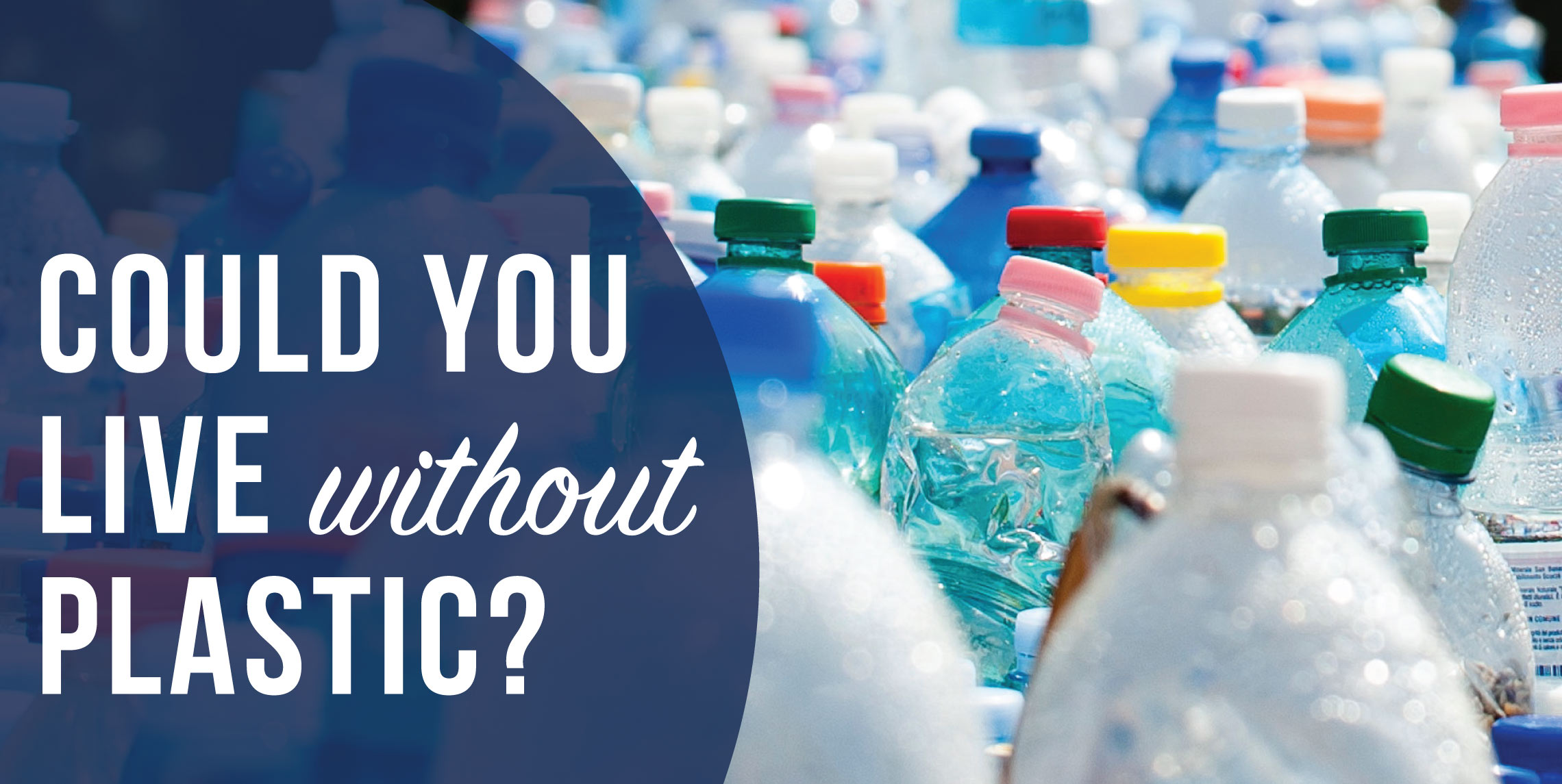
Growing up I never thought twice about tossing anything into the trash. Using plastic straws daily, frequently drinking bottled water, and eating individually packaged snacks in plastic never occurred to me to be an issue. Did you know that each week you are on average consuming 5g of plastic? Or that you can consume 250g of plastic each year? OR that you could consume 20kg of plastic in a lifetime!? That’s the equivalent of 2 mobile recycling bins worth! (1) I believe plastics are one of the absolute most important problems if not, THE most important problem the environment and all life on Earth face today. Plastics seem impossible to live without, yet, seem impossible to live within abundance.
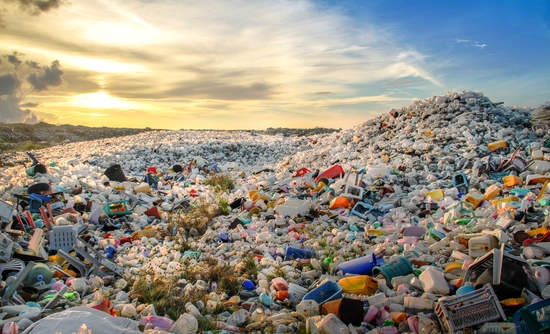
First off, let’s briefly cover the history of plastics and generally what plastics are. Plastics are synthetic or semi-synthetic materials made from polymers such as polyvinyl chloride, polyethylene, polystyrene, or polypropylene in combination with other chemicals. (2) Man-made plastic was first created in 1862 from organic cellulose. Then, between 1868 and 1870 a plastic named celluloid was made from cellulose and camphor. After that, in 1907, the first synthetic polymer, derived from fossil fuels instead of plants, was created from phenol and formaldehyde. (3) Considering that formaldehyde is a known human carcinogen, it’s safe to say that at this point in history, plastics are starting to get a bit alarming. (4)
At first, plastics seemed extraordinary. Having a material so readily available to be used for anything allowed us to protect the environment from a growing demand for natural resources as well as lower manufacturing and consumer costs. However, while we were protecting natural resources like ivory and wood, we began using more fossil fuels in combination with chemicals that we don’t fully understand. As the years have gone on, plastics have gotten more complicated and less recyclable. Now, plastics are created from so many chemical combinations that we don’t know the true contents of each piece of plastic. For example, a 2019 study detected more than 1,000 chemicals from only 34 everyday plastic items! 80% of the chemicals detected in the study were unknown. (5) We are exposed to plastics daily through food, water, and air among other ways of exposure all the while, we still, after over 100 years, don’t fully understand plastics and their effects on the planet and all life on it. 
Serious effects from plastics happen from repeated use and exposure. This means negative problems caused by plastic could take a while to show up. However, when we are exposed to plastics every day from all directions, repeated use and exposure are easily accomplished. Therefore, it takes less time for negative problems due to plastic exposure to occur because we are constantly exposed to plastic and the chemicals each piece is made of. This is why plastics don’t need to be so widely and freely used. Safe and sustainable materials, as well as ways of consumption, are all around.
During WW2 plastic production in the United States increased 300% and the rise in production has only continued to increase, despite signs of overuse and destructive effects. (6) After WW2 factories were converted from military to consumer production. Plastics were favored by companies so much that they began to replace traditional materials like steel, paper, glass, and wood because they could be produced endlessly and for less money. (7) Despite a newfound consumer acceptance for plastics, concerns about plastics and plastic pollution began to significantly increase as people began noticing plastics accumulating in the environment.
Observations of ingested plastic pieces by seabirds date back to the 1960s. (8) And in 1972, polystyrene covered in PCBs and bacteria were found in fish off the coast of southern New England. (9) These were just two examples of the beginning of the perceivable negative effects of plastic. In the 1970s and 1980s more people began to realize that while plastics were convenient, cheap, and disposable, they remain in the environment forever. Not only do plastics end up in the environment, but they migrate into our water, air, and find their way into our bodies and the bodies of all lives on Earth, where they wreak havoc and leach toxic chemicals among other problems.
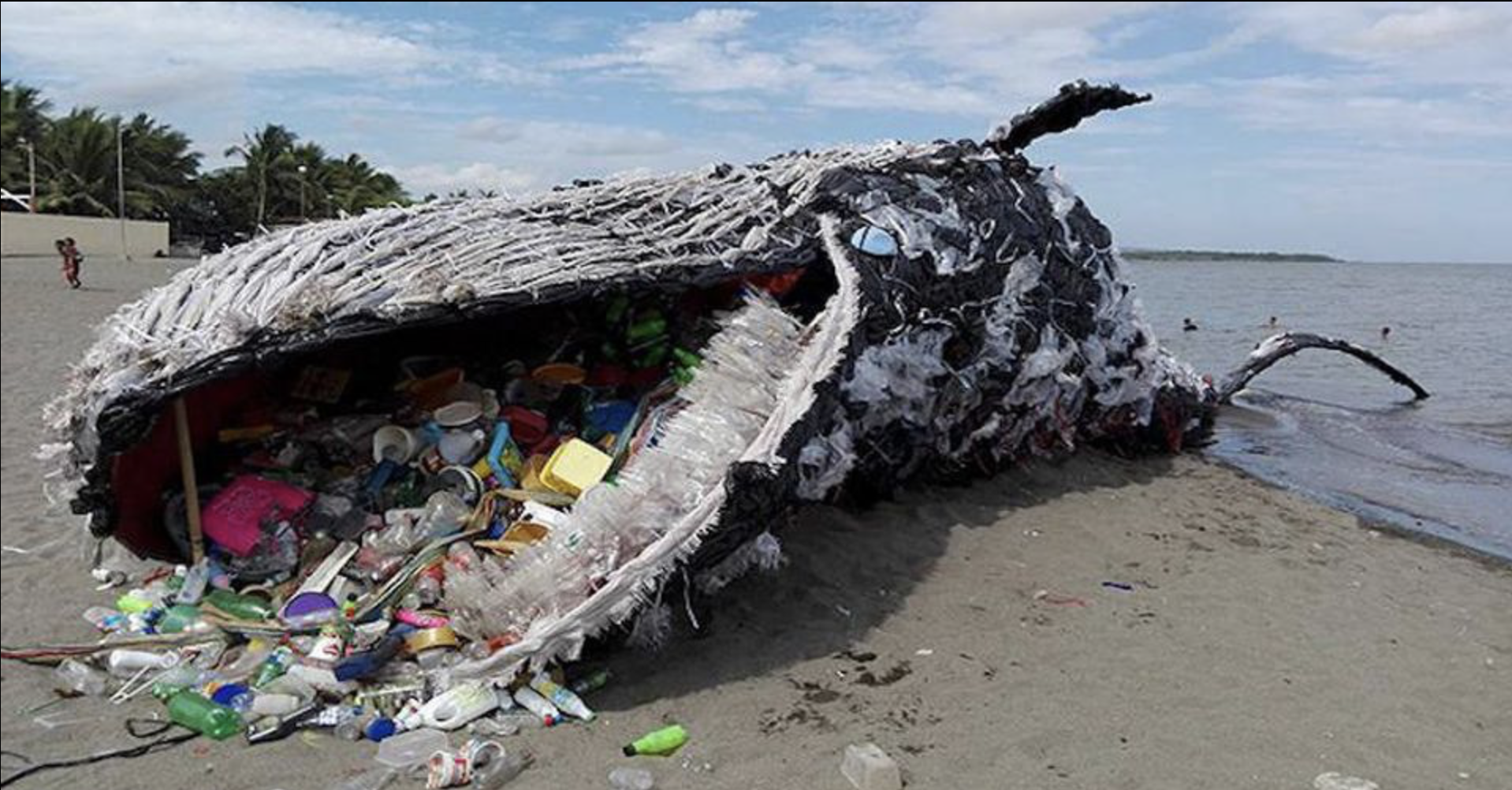 In the late 1980s, the plastics industry (makers of oil and gas) began to worry about the increasingly negative views on plastics. They chose to spend tens of millions of dollars promoting recycling. However, oil and gas companies knew all along that the majority of plastic produced can’t or won’t be recycled. Internal records of the plastic industry dating back to the 1970s show that they knew large-scale plastic recycling would never be economically practical. Larry Thomas, a former head of SPI, the plastic industry’s lobbying group, recalled the plastic industry felt if the public thinks recycling is working, the public won’t be concerned about the environment. In the past 40 plus years, less than 10% of plastic produced has been successfully recycled. (10) The plastics industry wants to keep making money off fossil fuels like natural gas, oil, and coal that exploit the planet and all life on it to produce cheap plastics and give them big profits. The plastic industry felt it was the responsibility of consumers to handle plastic pollution, yet they are the ones producing the plastic in the first place. If they had chosen to only use plastics where absolutely necessary, we would be in a much different world right now in 2021.
In the late 1980s, the plastics industry (makers of oil and gas) began to worry about the increasingly negative views on plastics. They chose to spend tens of millions of dollars promoting recycling. However, oil and gas companies knew all along that the majority of plastic produced can’t or won’t be recycled. Internal records of the plastic industry dating back to the 1970s show that they knew large-scale plastic recycling would never be economically practical. Larry Thomas, a former head of SPI, the plastic industry’s lobbying group, recalled the plastic industry felt if the public thinks recycling is working, the public won’t be concerned about the environment. In the past 40 plus years, less than 10% of plastic produced has been successfully recycled. (10) The plastics industry wants to keep making money off fossil fuels like natural gas, oil, and coal that exploit the planet and all life on it to produce cheap plastics and give them big profits. The plastic industry felt it was the responsibility of consumers to handle plastic pollution, yet they are the ones producing the plastic in the first place. If they had chosen to only use plastics where absolutely necessary, we would be in a much different world right now in 2021.
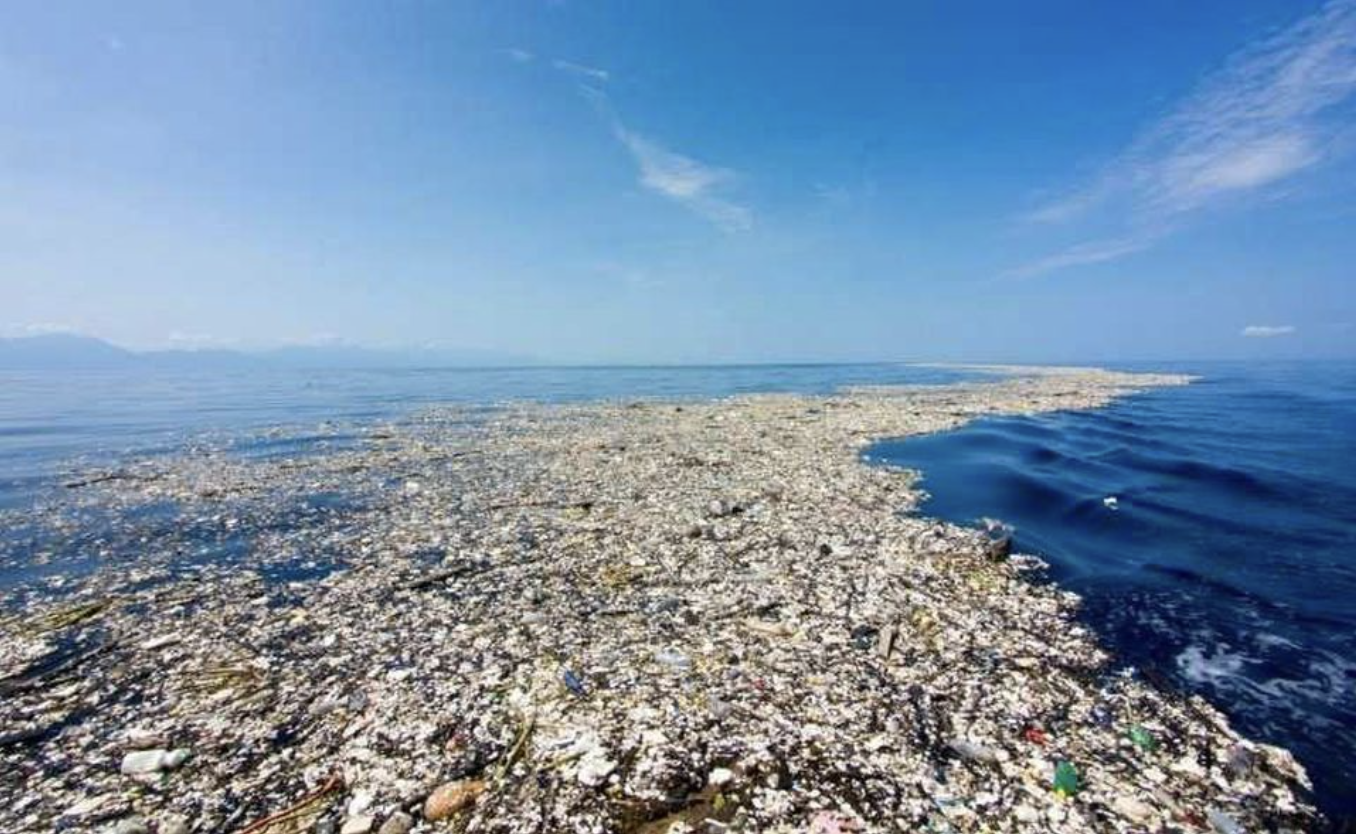 Through the 1990s, the plastic industry continued to promote recycling to curb initiatives to ban plastics. Then, in 1997, Charles Moore discovered the Great Pacific Garbage Patch. The GPGP, now 1.6 million square kilometers large (at least TWICE the size of Texas and the weight of 500 jumbo jets), is now one of FIVE offshore plastic accumulations in our world’s oceans. 1.15 - 2.41 million tonnes of plastic enter the ocean each year from rivers. Ocean plastic is predicted to triple by 2050 unless we all demand major producers of plastic change their ways of production and the demand is met with a major response. (11) This is only one area plastic is accumulating in the environment. We are sending over 27 million tonnes of plastic to US landfills yearly where they take up valuable space, leach toxic chemicals, and break down into micro-plastics. (12) As of 2018, the world has produced 8.3 billion metric tonnes of plastic and 6.3 billion metric tonnes of it has become waste. We are also sending about 22 million pounds of plastic into our great lakes each year. Humans and animals alike rely significantly on the great lakes for clean, drinkable water. (13) Plastic pollution in our environment is only one of the very serious effects of excessive plastic production and consumption.
Through the 1990s, the plastic industry continued to promote recycling to curb initiatives to ban plastics. Then, in 1997, Charles Moore discovered the Great Pacific Garbage Patch. The GPGP, now 1.6 million square kilometers large (at least TWICE the size of Texas and the weight of 500 jumbo jets), is now one of FIVE offshore plastic accumulations in our world’s oceans. 1.15 - 2.41 million tonnes of plastic enter the ocean each year from rivers. Ocean plastic is predicted to triple by 2050 unless we all demand major producers of plastic change their ways of production and the demand is met with a major response. (11) This is only one area plastic is accumulating in the environment. We are sending over 27 million tonnes of plastic to US landfills yearly where they take up valuable space, leach toxic chemicals, and break down into micro-plastics. (12) As of 2018, the world has produced 8.3 billion metric tonnes of plastic and 6.3 billion metric tonnes of it has become waste. We are also sending about 22 million pounds of plastic into our great lakes each year. Humans and animals alike rely significantly on the great lakes for clean, drinkable water. (13) Plastic pollution in our environment is only one of the very serious effects of excessive plastic production and consumption.
Now that we know the basic history of plastics and what they’ve done on Earth since they were created, let’s get into what they are composed of and how each stage of their life affects life. We know that plastics are made from polymers but what does the process from beginning to end look like? Plastics begin with extracting crude oil and natural gas from the Earth by drilling or fracking and in some cases mining for coal. Then, these materials are transported to be refined, compounded, and processed. Gas, oil, and coal go through a “cracking process” where larger molecules from the oil and gas are refined into monomers like ethylene and propylene. They then undergo polymerization reactions to produce polymer resins. These resins are processed further by adding dyes, stabilizers, UV-blockers, antioxidants, flame-retardant chemicals, and plasticizers to name a few. (14 & 15) After the polymer resins are mixed with additives, they are processed some more, heated, molded, and cooled into their desired products. The result is a piece of plastic imprinted with a code that corresponds to the resin type.
While additives are useful in transforming plastics to meet any requirement, they are also chemicals that increase plastic leaching and expose humans and all life to toxic chemicals. Additives, byproducts, solvents, unreacted monomers, starting substances, and degradation products are released throughout all phases of a plastic’s lifecycle. (16 & 17) These chemicals are released by migration into liquids and solids as well as by volatilization. Additives easily leach from polymers because they are not usually bound to the plastic structure. Plastic producers rarely disclose what additives plastics may contain. This is deeply concerning considering all finished plastics contain intentional residual chemicals used for their manufacturing as well as unintentionally created chemicals. (18)
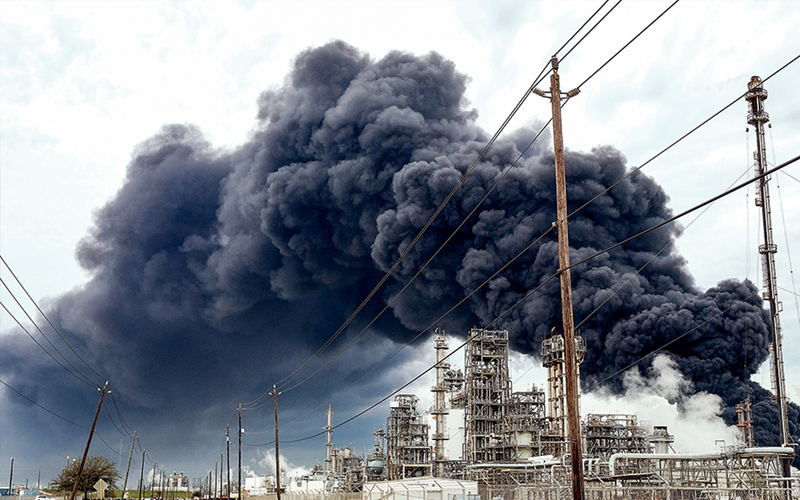 Extracting and refining fossil fuels to create plastics significantly pollutes the environment. More than 90% of the energy and resources used to create plastics come from fossil fuel resources. (19) Therefore, the more plastic we produce and consume, the more petrochemicals we need to extract and process. National Geographic predicts that plastic production will more than double by 2050. (20) An estimated 12.5 to 13.5 million metric tonnes of carbon dioxide equivalent are emitted per year in the United States alone to extract and transport fossil fuels to create plastics. (21) Land degradation, surface and groundwater pollution, air pollution, environmental racism, night-time chemical releases, and emissions, are just a few results from the carbon-intensive process of extracting, transporting, and producing plastics. Refining and manufacturing plastics are even more damaging than extracting and transporting fossil fuels. In 2015, the CIEL recorded that emissions from manufacturing ethylene to make polyethylene alone were 184.3 to 213 million metric tonnes of carbon dioxide equivalent. (21) That’s about the same amount of emissions 45 million passenger vehicles release during a full year! This is why we all need to work on changes to avoid plastics and the consumption of single-use materials in general.
Extracting and refining fossil fuels to create plastics significantly pollutes the environment. More than 90% of the energy and resources used to create plastics come from fossil fuel resources. (19) Therefore, the more plastic we produce and consume, the more petrochemicals we need to extract and process. National Geographic predicts that plastic production will more than double by 2050. (20) An estimated 12.5 to 13.5 million metric tonnes of carbon dioxide equivalent are emitted per year in the United States alone to extract and transport fossil fuels to create plastics. (21) Land degradation, surface and groundwater pollution, air pollution, environmental racism, night-time chemical releases, and emissions, are just a few results from the carbon-intensive process of extracting, transporting, and producing plastics. Refining and manufacturing plastics are even more damaging than extracting and transporting fossil fuels. In 2015, the CIEL recorded that emissions from manufacturing ethylene to make polyethylene alone were 184.3 to 213 million metric tonnes of carbon dioxide equivalent. (21) That’s about the same amount of emissions 45 million passenger vehicles release during a full year! This is why we all need to work on changes to avoid plastics and the consumption of single-use materials in general.
Now that we know how plastics are sourced, created, and a little about how production affects life on Earth, let’s cover each of the 7 plastic resin codes we encounter daily to learn their individual uses, effects, and recyclability. I have also created a Plastic Identification Guide you can print off or keep on your phone to help you understand plastics you are using and recycling.

#1 PETE/PET: Polyethylene Terephthalate
PETE is used to make bottled water, bottled beverages, tea bags, and single-use items like cups, lids, and clamshells. PETE is easily recyclable. The keyword with this resin type is phthalate. Phthalates are added to plastics to make them softer. However, phthalates are loosely attached to plastic structures and they tend to move from plastics to the contents of plastic and ultimately into our bodies and the environment. Phthalates are endocrine disruptors that have been associated with reproductive malformations, reduced fertility, developmental disorders, increased allergic reactions, asthma, and are also a concern for affecting brain development. Fetuses and young children are especially at risk. (22) A study from over two decades ago showed phthalates present in the urine of 75 - 90% of people tested in the study. (23) In addition to leaching phthalates, PETE can also leach antimony when under heat stress. (24) Antimony is a semi-metal that after repeated exposure from days to weeks can cause nausea, vomiting, and diarrhea. (25) Steeping a single plastic tea bag made of PETE at a brewing temp of 204 degrees Fahrenheit releases approximately 11.6 billion micro-plastics and 3.1 nano plastics into a single cup! (26)

#2 HDPE: High-Density Polyethylene
HDPE is used to make items like milk jugs, detergent bottles, cereal liners, juice bottles, and grocery bags. HDPE is the most commonly recycled plastic. HDPE is a safer choice of plastic that is hard-wearing, heat-resistant, and cost-effective to recycle as long as it isn’t in the form of bags. However, HDPE may leach estrogenic chemicals. (27)

#3 PVC : Polyvinyl Chloride
PVC is used for pipes, food packaging, shrink wrap, plastic wrap, shower liners, flooring, oil bottles, and nut butter jars. PVC is only recycled at specialized facilities. PVC contains many hazardous additives and leaches harmful chemicals like dioxins, BPA, phthalates, vinyl chloride, lead, and formaldehyde. PVC has a high chlorine content and may contain more than 40% plasticizers (ex. Phthalates) by weight. (28) The fact alone that PVC can leach dioxins is extremely concerning. Dioxins are considered some of the most poisonous chemicals ever studied and are a known human carcinogen. (29) Children are especially at risk for exposure to chemicals from PVC. A 2009 study showed that exposure to PVC flooring can increase the chances of developing asthma and autism. (30) Children in homes with vinyl flooring are twice as likely to develop autism. (30) PVC flooring can off-gas up to 40 chemicals and installing a new PVC product like a shower curtain can release up to 108 volatile organic compounds into the air over 28 days. (30) Therefore, indoor PVC items can make indoor air quality poorer than outdoor air.

#4 LDPE: Low-Density Polyethylene
LDPE is used for trash bags, bread bags, produce bags, six-pack rings, as well as lining in paper products. LDPE is difficult to recycle since it tends to be in bag form. LDPE is a safer choice of plastic because it is durable and it resists acids, bases, and oils. (31) However, HDPE may leach estrogenic chemicals. (27)

#5 PP: Polypropylene
PP is used to make yogurt containers, sour cream containers, butter containers, straws, furniture, clothing insulation, and shipping bags. PP is accepted at most recycling facilities. PP is a safer choice of plastic because it has a high heat tolerance but it has been shown to affect androgen hormones. (32)

#6 PS: Polystyrene
PS is used for to-go containers, utensils, seafood and meat trays, egg cartons, CD cases, and packing materials. PS is not easily recycled. PS is a hazardous plastic because it easily leaches known carcinogens and neurotoxins benzene and styrene. (33) Heat significantly increases PS leaching. Therefore, placing hot foods into PS or heating PS is dangerous. A 1986 National Human Adipose Tissue Survey identified styrene residues in 100% of all samples tested. (34)

#7 Other
Other is used when plastic does not fit into codes 1 through 6. This code includes recyclable, non-recyclable, “biodegradable”, multi-layer, and mixed resin plastics. Examples of plastics that fall into #7 are Nylon, Acrylic, ABS, Polycarbonate, PLA, and PTFE. Items typically made from number 7 are glasses, DVDs, CDs, baby bottles, car parts, and electronics. Number 7 plastics are hard to recycle in curbside recycling bins. Number 7 plastics can leach BPA, BPS, affect the endocrine system, as well as increase risk for metabolic disorders, breast cancer, prostate cancer, and heart disease. (35, 36)
PTFE, or better known as the brand name Teflon, releases fumes into the air when cookware coated in it is overheated. A study conducted in 1991 showed that when Teflon cookware reached 464°F, PTFE particles were measured in the air and at 680°F toxic gases were released. These gases are known to be carcinogenic to animals and poisonous to plants. (37) Studies have shown increased cancer rates in humans who work in and live by chemical plants where PTFE and PFAs are used to manufacture Teflon. (38) It only takes 2 to 5 minutes for cookware on a conventional stovetop to be heated enough to release these gases. Exposure is significantly increased if Teflon coated items are used in an oven or on a grill. Not only does this coating release particles and gases into the air, but it also can flake off into food, and these chemicals never break down in the environment.
EWG estimates that up to 110 million Americans could have drinking water contaminated with PFAs. (39)
Since plastics do not biodegrade, they break down into smaller and smaller pieces of plastics known as micro-plastics. Micro-plastics are fragments, pellets, beads, fibers, and films less than 5mm in diameter. Most of the micro-plastics in our oceans come from rivers and streams. All wildlife in and around rivers, streams, and oceans are exposed to threats of micro-plastic pollution. (40) This happens unintentionally as well as intentionally. When micro-plastics float on the surface of water or get buried in the sand they are often mistaken as food sources and are a serious threat to marine habitats. In 1960 plastic was found in 5% of all seabirds and that number dramatically increased to 80% in 2010 and is expected to increase to 99% in 2050 if we continue consuming plastic at the rate we are. (41) Micro-plastics are digested by organisms as small as zooplankton. At least 386 marine fish species are known to have ingested plastic debris. 210 of these species are commercially important. Nano-plastics ingested by marine life can move from their stomach to muscle tissue. (42)
A study done on 15% of American’s annual caloric intake estimated that 39,000 to 52,000 plastic particles are ingested. These estimates rose to 740,000 to 121,000 when also including particles by inhalation. Individuals who only consume water through bottled sources increased their yearly micro-plastic particle intake by an additional 90,000. Those who consumed only tap water increased their yearly total by 4,000. These totals were likely underestimated. (43) A 2017 study hypothesized that the cumulative effect of ingesting plastics over time can be toxic. (40) The build-up of toxic contents of plastics can impact the immune system, digestive tract, as well as cause problems with the cardiovascular system among other issues. (44) A top source of consumed microplastics for humans comes from synthetic fibers like clothing, blankets, rugs, carpet, etc. During one meal at home, you could be consuming around 100 micro-plastics due to synthetic household fibers. (45) A single wash of synthetic fabrics like nylon and acrylic may release 700,000 micro-plastics into the environment.
The number one way plastic waste is created is through purchasing items in and of plastic. This can be anything from drinks, food, clothing, cleaning products, office supplies, makeup, to shampoo and conditioner. Many products are packaged in plastic but, chances are, there are options not in plastic or that you can request to be of as little waste as possible. Sometimes it simply takes you asking if there are any alternatives!
For example, when my husband and I get iced coffee, we ask for a paper cup and no lid that we use a reusable straw with as opposed to a plastic cup, lid, and straw. It can be hard at first to teach yourself to think ahead but with practice it becomes instinctive. If you start to take note of how much plastic you encounter each day, you can slowly address each area and find out what alternatives you have. Maybe you can get that to-go food in paper instead or at least packaged in less plastic. Maybe you ask for no plasticware or no plastic straw. Maybe you ask for no bag. Maybe you choose to start getting an item in bulk. This process is an individual journey of finding what works for you and what ways you can reduce waste in your life. Frequently remind yourself why you are making these decisions and how every piece of plastic ever made will remain on the earth in some form for eternity, polluting the world. Plastics you choose to consume will migrate around polluting our bodies, land, air, waterways, animals, and aquatic life. “If you don’t want it in your body, don’t increase the material flow of it into society”. (46)
Choose to buy from bulk when possible! Familiarize yourself with places that offer bulk products in your area and what their selection is. Luckily for you, Mama Jean’s offers a vast bulk selection from nuts to flour to lentils to spices to olive oil to soap nuts and beyond! Keep an eye out for containers and items you can repurpose to hold your bulk items. All you have to do is bring in your bulk containers to a register to tare their weight and you are ready to fill up! Once you know the weight of a container or sack you can write the weight on it with a permanent marker so you don’t have to have it weighed each time. I suggest using repurposed glass and plastic containers as well as purchasing some cotton bulk sacks. You could even invest in a labeler to keep bulk items organized. When you buy products in bulk you don’t have to consume or pay for packaging and you get a discount! Thrift stores, garage sales, and your recycling are perfect places to find containers and jars for any bulk need.
Buy produce free of plastic packaging. This is a major way to cut down on plastic waste. Most plastics used for produce like nets and bags can’t be recycled. Tip: if you find yourself with a plastic net bag that you need to dispose of, make sure to cut up the bag first so animals don’t get trapped in it. The same routine goes for disposing of plastic rings used to hold six-packs. If you are someone who frequently uses plastic produce bags when buying produce, choose instead to use reusable cotton net produce bags, paper bags, toss the produce in your reusable shopping bags, grab a cardboard box, or simply carry the produce. All produce is going to be cut up and eaten anyway! Familiarize yourself with what stores in your area carry produce items you like without plastic packaging. Lucky you, again, Mama Jean’s has a large selection of unpackaged, local, and organic produce.
Choose to buy products locally if possible. Ordering online may be convenient but it produces a lot of waste and takes away from local businesses. However, I understand this isn’t always avoidable. If you choose to order online, make sure to recycle and reuse all packaging. You can even ask the company if they can use as little waste as possible or choose companies that use sustainable packaging and offset carbon emissions.
Experiment with alternatives to products packaged in plastic. If you always purchase shampoo and conditioner in plastic bottles, try out a refillable shampoo and conditioner company! Visit SOAP Refill station here in Springfield or buy our bulk soaps from Rustic Strength. You can also make your own products, or try shampoo and conditioner bars. If you frequently buy ranch dressing packaged in plastic, try out a ranch packaged in glass, or make your own with herbs found in the bulk section of MaMa Jeans. Sometimes finding alternatives you like can be a slow process, but over time you will have more sustainable habits and purchases. Something that helped me was setting a limit for the amount of plastic-packaged items I purchased each time I shopped for groceries or anything. Also, if you use a delivery service to buy groceries, you can request no plastic or as little as possible and choose items without plastic.
Reducing plastic while eating out and getting to go-food can be hard. Steps to reduce your waste while getting food from restaurants is to, first of all, ask for alternatives to plastic or as little plastic as possible. For example, my husband and I love salad from IMO’s Pizza. Usually, they package this salad in a polystyrene box, add plastic utensils, add dressing in a plastic portion cup with a lid, and plastic-wrapped crackers. We request for the salad to be in one of their aluminum pasta containers with the dressing on top of the salad, no utensils, and no crackers. This way, we only have the aluminum container that we can wash and recycle. Ordering ahead gives you a great opportunity to ask the restaurant what plastic alternatives they have. Asking for no plastic bag, utensils, and straw is routine for us now. Most things don’t need a bag and if we absolutely need one, we just use one of our reusable totes. We keep reusable bags, straws, and silverware with us in the car and our bags so we are always prepared. You can also choose to buy reusable straw and silverware carriers to keep your utensils clean! Finding alternatives to plastics in your life can take a while but if you make yourself aware of all areas of your life they appear in, you can start changing habits and ways of consuming food, drinks, apparel, bath and body care items, kitchen items, textiles, cleaning products, feminine hygiene products, etc. Choosing long-lasting, unpackaged, recyclable, and repurpose-able items is the way to go.
Every time you purchase items of and in plastic, you are using your money to vote for plastic and its damaging, eternal life cycle. When I think back to the lack of consideration I had for my health and the world around me as I was growing up, I am in disbelief. I would never have made so many negative choices had I known the true, everlasting consequences plastics have. However, I was completely unaware of the consequences of my actions because no one explained them to me. Often our society is so focused on making our lives as convenient as possible in the short term, and in the long run, the health of all life on Earth is at the expense of those everyday conveniences. This is the reason I chose to write this article. I am writing this article for you.
It breaks my heart to think of all the damage plastic has caused and continues to cause daily to all life on this planet. I hope that this article empowers you and aids you in finding ways you can personally choose alternatives to plastics and waste in general and set an example for others to help the world around you become safer and healthier. Once you are presented with these facts, the veil is removed and you can choose to either live each day making better choices for your health and the health of those around you or you can choose to make choices that may harm your own life as well as lives around you. Spread awareness, speak up, influence others, and set an example. Small local changes affect large global changes! Remember to be easy on yourself as you are making lifestyle changes and remind yourself that this is all a learning experience. You will make mistakes and forget at times.
Are you willing to accept toxic industrial chemicals invading your food, drinks, body, air, water, ground, oceans, and all life on earth? I’m not! I believe we have to come together to take on the negative decisions of others and bring justice to all life on Earth. We have to repair the damage that has been done so that our future and future generations can live in a safer world. I will fight against this injustice until the day I die and I hope you will join me. Take pride and responsibility for this plant that is our home. Remember that “Whatever befalls the Earth, befalls the people of the Earth” - Chief Seattle.
 Earth Day Is Everyday!
Earth Day Is Everyday!
This article was written by our awesome Jeaner, Baylee Marler. A native of the Ozarks, Baylee has a loving husband and two cats named Sage and Saffron. She loves to express her creativity and help spread awareness to global issues. Genuinely caring about the preservation of our natural resources, Baylee spends all the time she can taking care of and admiring the Earth. Shifting society away from the single use lifestyle and towards a sustainable future is her goal.
Sources:
-
Plastic Industry Spent Millions Selling Recycling — To Sell More Plastic
-
Phthalate Release from Plastic Fragments and Degradation in Seawater
-
Association between phthalates and attention deficit disorder in U.S. children
-
Assessment of metal contaminations leaching out from recycling plastic bottles
-
Plastic Teabags Release Billions of Microparticles and Nanoparticles into Tea
-
https://www.nationalgeographic.com/science/article/100115-bpa-bisphenol-a-heart-disease#:~:text=Bisphenol-A%2C%20or%20BPA%20—a%20common%2C%20human-made%20chemical%20that,It%20also%20lines%20the%20inside%20of%20food%20cans.
-
Perfluorooctanoic Acid (PFOA), Teflon, and Related Chemicals
-
https://www.nationalgeographic.com/environment/article/you-eat-thousands-of-bits-of-plastic-every-year#:~:text=She%20says%20it%27s%20important%20to%20remember%20that%20microplastics,reason%2C%20she%20describes%20microplastics%20as%20having%20“multiple%20personalities.”
-
Hundreds of Fish Species, Including Many That Humans Eat, Are Consuming Plastic
-
Exposed to extreme heat, plastic bottles may ultimately become unsafe
Getting Involved
Springfield, MO Recycling Guide
Extra Credit:
History of “Cancer Alley” USA Cluster of Chemical Plants
https://www.getmosoap.com/
My Favorite Shampoo And Conditioner Bars
Reusable Straw and Utensil Carriers
Reusable Round Cotton Rounds and Cotton Menstrual Pads
Reusable Glass Spray Bottle with Sleeve
Reusable Cotton Net Prodduce Bag Set
Plastics and PCBs Causing Major Problems in Our Oceans
